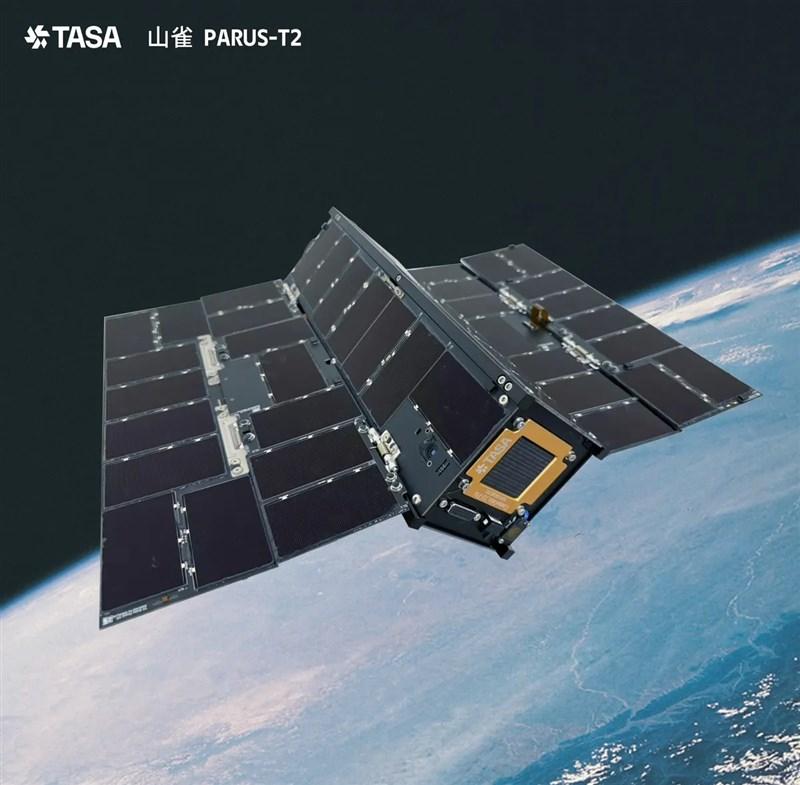A CubeSat designed and made by the Taiwan Space Agency (TASA) was yesterday launched into space from the Vandenberg Space Force Base in California, TASA said in a statement today.
The PARUS-T2, carried by a Space Exploration Technologies Corp (SpaceX) Transporter-14 rocket, was launched at 2:25pm California time and positioned in low-earth orbit at an altitude of 621km about 136 minutes after that, TASA said.
It connected with an overseas earth station two hours after positioning in orbit and was expected to connect with Taiwan's earth station at 10pm today, TASA said.

Photo courtesy of the Taiwan Space Agency via CNA
A cube satellite, or CubeSat, is a miniaturized satellite made up of multiple cubic modules of about 10cm³.
The PARUS-T2, a CubeSat measuring 30cm by 10cm by 10cm, is based on the PARUS-T1, which was sent into orbit on Jan. 15, but improvements were made to its satellite computer, power control system, satellite battery and global navigation satellite system receiver.
It has a new deployment mechanism to unfold its solar panel and is equipped with an altitude determination and control system developed by Taiwanese company Tensor Tech, TASA said.
It also carries a communication payload and an automatic packet reporting system payload, both made in Taiwan, the agency said.
The primary 12-month mission is to verify the satellite's performance, with the goal of improving the reliability of CubeSats developed by TASA, it said.
Once their reliability is confirmed, TASA hopes to develop a stable supply of CubeSats for commercial and academic use, ultimately boosting Taiwan's global competitiveness in the space industry, the agency said.
The PARUS project was named after Taiwan's indigenous Sittiparus castaneoventris, or chestnut-bellied tit, with the hope that domestically made satellites would fly high into the sky, TASA said.
The next PARUS CubeSat, PARUS-6U1, is expected to be launched in October carried by a SpaceX Transporter-15 rocket, it added.

SHIPS, TRAINS AND AUTOMOBILES: The ministry has announced changes to varied transportation industries taking effect soon, with a number of effects for passengers Beginning next month, the post office is canceling signature upon delivery and written inquiry services for international registered small packets in accordance with the new policy of the Universal Postal Union, the Ministry of Transportation and Communications said yesterday. The new policy does not apply to packets that are to be delivered to China, the ministry said. Senders of international registered small packets would receive a NT$10 rebate on postage if the packets are sent from Jan. 1 to March 31, it added. The ministry said that three other policies are also scheduled to take effect next month. International cruise ship operators

NUMBERS IMBALANCE: More than 4 million Taiwanese have visited China this year, while only about half a million Chinese have visited here Beijing has yet to respond to Taiwan’s requests for negotiation over matters related to the recovery of cross-strait tourism, the Tourism Administration said yesterday. Taiwan’s tourism authority issued the statement after Chinese-language daily the China Times reported yesterday that the government’s policy of banning group tours to China does not stop Taiwanese from visiting the country. As of October, more than 4.2 million had traveled to China this year, exceeding last year. Beijing estimated the number of Taiwanese tourists in China could reach 4.5 million this year. By contrast, only 500,000 Chinese tourists are expected in Taiwan, the report said. The report

The Forestry and Nature Conservation Agency yesterday launched a gift box to market honey “certified by a Formosan black bear” in appreciation of a beekeeper’s amicable interaction with a honey-thieving bear. Beekeeper Chih Ming-chen (池明鎮) in January inspected his bee farm in Hualien County’s Jhuosi Township (卓溪) and found that more than 20 beehives had been destroyed and many hives were eaten, with bear droppings and paw prints near the destroyed hives, the agency said. Chih returned to the farm to move the remaining beehives away that evening when he encountered a Formosan black bear only 20m away, the agency said. The bear

HORROR STORIES: One victim recounted not realizing they had been stabbed and seeing people bleeding, while another recalled breaking down in tears after fleeing A man on Friday died after he tried to fight the knife-wielding suspect who went on a stabbing spree near two of Taipei’s busiest metro stations, Taipei Mayor Chiang Wan-an (蔣萬安) said. The 57-year-old man, identified by his family name, Yu (余), encountered the suspect at Exit M7 of Taipei Main Station and immediately tried to stop him, but was fatally wounded and later died, Chiang said, calling the incident “heartbreaking.” Yu’s family would receive at least NT$5 million (US$158,584) in compensation through the Taipei Rapid Transit Corp’s (TRTC) insurance coverage, he said after convening an emergency security response meeting yesterday morning. National